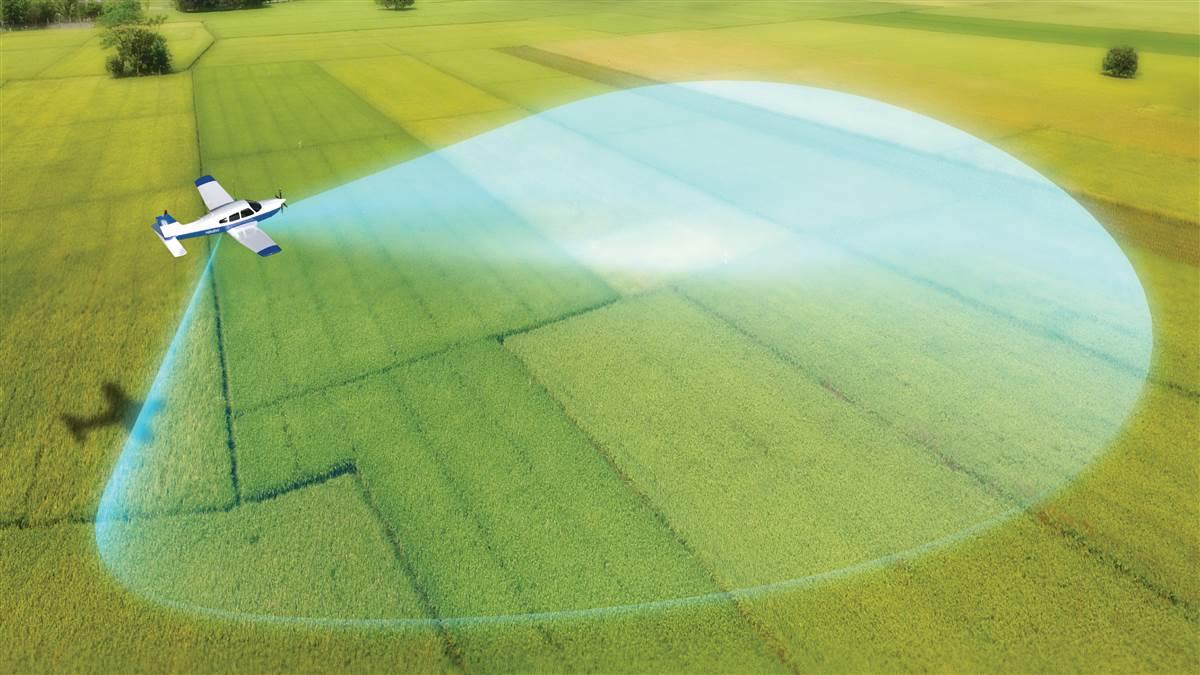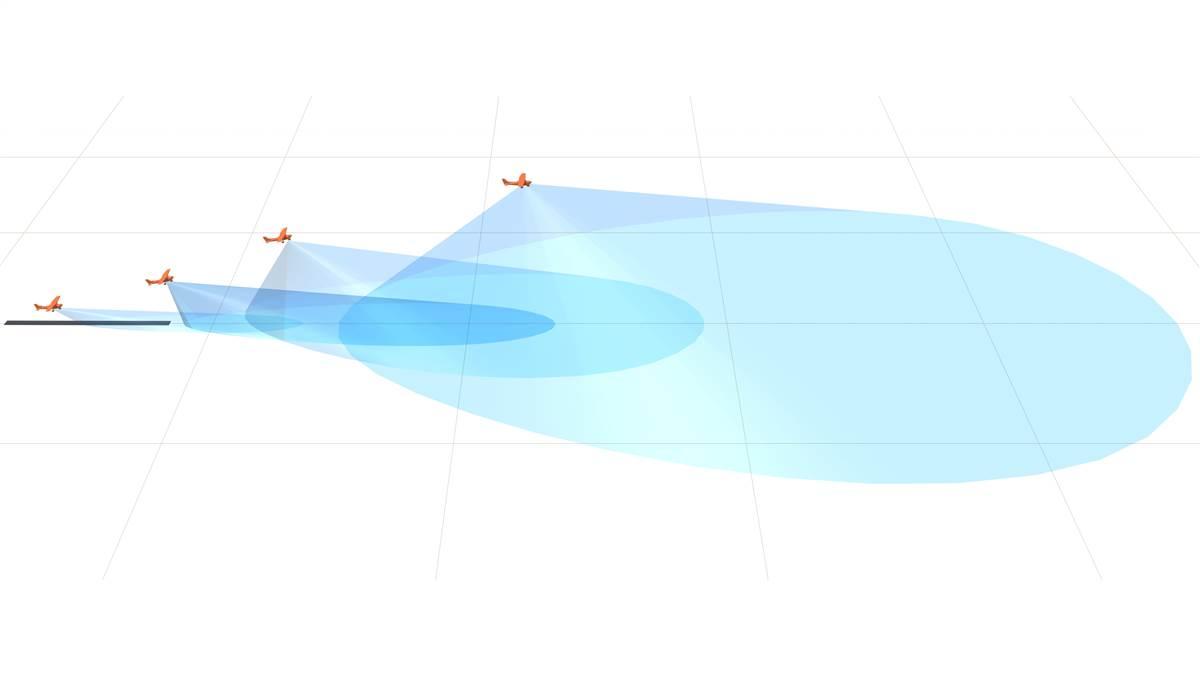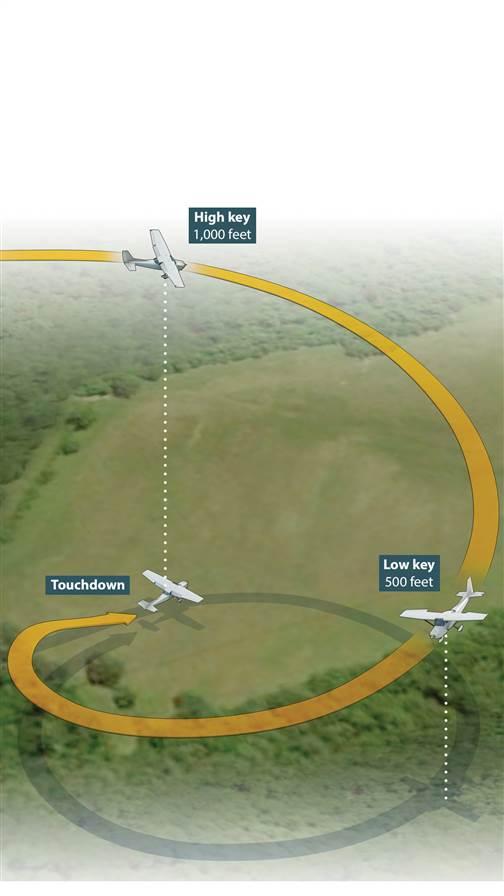Bundle of energy
Know how much you’ve got—and how far you can go

Energy footprint
The combination of airspeed and altitude the airplane possesses at the time of engine failure defines those points on the ground the airplane is capable of reaching. It’s an energy footprint. The concept of an energy management footprint is a way of visualizing how the energy of an airplane builds and changes on takeoff and how that affects our options when planning landing sites in the event of an engine failure. The bigger the energy footprint, the more choices a pilot has when the propeller stops propelling.
If the engine stops, an airborne airplane still has two types of energy working in its favor: kinetic energy (speed) and potential energy (height above the ground). These two elements comprise mechanical energy, and one can be traded for the other—sacrifice speed to gain altitude, or vice versa. Meanwhile, the airplane slowly loses energy to the friction from aerodynamic drag. A complex three-dimensional dance between these factors affects how far an airplane can glide to a landing spot.
There is not a one-size-fits-all energy footprint. In any flight situation, every airplane has its own, unique footprint that is driven not only by characteristics of the airplane itself (weight, wingspan, power, and more) but also by the conditions it is operating in. Hot air decreases the aircraft’s ability to utilize that energy, so the footprint shrinks. Cold air increases it. Winds can help or hinder it. The shape and dimensions of an airplane’s energy change by the second. The only thing that stays the same is the basic physics concept in which the altitude and speed interact and define those areas that the airplane can reach without engine power.

 Building the footprint
Building the footprint
When the power goes in on takeoff, the potential energy of altitude is zero, but kinetic energy begins to build instantly. In fact, kinetic energy increases as per the square of the speed.
The instant the airplane leaves the runway, the airplane’s potential energy begins to build as well. The airplane’s speed and the increasing height define an area the airplane could safely reach if the engine quit. Initially, the footprint is so narrow that the dictum about landing straight ahead applies, although even at only a few hundred feet a small turn to avoid obstacles can be accomplished safely.
As the speed builds and the airplane continues to climb, the area that can be reached extends ahead and widens out into a cone. All potential landing sites at this point are still somewhere ahead of the airplane.
Eventually, enough altitude is gained that a pilot can make a 90-degree turn right or left—or beyond—to utilize a more suitable landing space. Yes, an airplane will reach an altitude that moves the edges of the footprint around and behind the airplane. Theoretically, a 180-degree turn could be made back to the runway. However, it may not be worth the risk.
When an engine fails, the average pilot brain shrinks to the size of a pea, wasting valuable seconds in deciding on a plan of action. The pilot may use more time and altitude trying to remedy the glider state the airplane has just entered. Then, turning back to the airport requires aggressive maneuvering—executed with a ball-centered, minimum-altitude-loss, 180-degree turn—close to the ground.
You can practice at altitude to better understand what this turn-back is like. Climb to 2,000 feet and pretend that is ground elevation. Then, going over an easily identifiable checkpoint, such as a crossroads, slow to near stall speed and begin an imaginary takeoff and climb. Go up to 3,000 feet, reduce power to idle, count to five (simulating decision-making time), and turn around, heading for your checkpoint. It is critically important you do this with the ball centered and holding the best glide speed exactly. Do this a couple of times so you get a firm feeling of how close you have to be to the end of a runway to actually be able to make it with a large margin of error. Add 500 feet for your wife and kids and 200 feet for your dog. You’ll be surprised how much altitude you lose; the exercise should cure any of us from wanting to one-eighty back in all but the best circumstances.
From that altitude and speed, the energy footprint covers a sizeable number of emergency landing sites ahead and to the sides. It may be your best bet to ignore the runway and use the energy available to orchestrate a more or less normal approach to an off-airport landing.
High key, low key, and the energy footprint
As an airplane climbs out, the energy footprint becomes vaguely elliptical with the airplane well inside the aft edge. As the altitude goes up, the footprint becomes nearly circular because there is enough potential energy to turn in any direction. Setting up an approach to an emergency landing site is a matter of determining the high key position directly over the field, heading in the same direction as the “runway,” and descending to end up either at high or low key at the appropriate altitude.
The overall concept of “high key” and “low key” position comes from the military, which incorporates high- and low-key altitudes into every approach. In this context, high key is the altitude over the runway from which the airplane can make a 360-degree, continuously turning approach when power is off. The military defines the point opposite the threshold on downwind—the point from which a 180-degree turn can be made and reach the runway—as the low key position. (Some civilian authors put high key on downwind opposite the threshold, and some put low key on base.) Every military airplane has a known high-key altitude and speed clearly written into the ops manual. The same information isn’t available for civilian aircraft, but it’s possible to approximate it with a little investigation.
Cruise along over a road at a fairly high altitude. Let’s make it 4,000 feet agl. At a crossroads, kill the power and enter a 2-minute, standard rate turn (prominent notch on your turn coordinator), slowing to best glide speed. Because a standard-rate turn (3 degrees per second) does a three-sixty in two minutes, you can guess fairly accurately at how much altitude it takes to do the three-sixty, based on your normal, power-off sink rate. A 500-fpm sink rate would require 1,000 feet (minimum) to come out on your original heading over your checkpoint. At the one-minute point, you should be abeam the threshold/checkpoint at 500 feet (low key position), with some variation because of different temperatures, aircraft characteristics, the exactitude applied to the turn, and other factors. Also, this is another area where we don’t want to work to minimums. If 1,000 feet is what it takes to make the three-sixty, considering adding a margin of up to 500 feet to our high key position—so we hit the low key, downwind position opposite the threshold with at least 750 feet in the bank. Although too much altitude generates its own problems, they are easily fixed while too-low problems are not. Establishing both the high and low key position requirements of any airplane are invaluable survival tools in the event of an engine failure.
Why worry about the energy footprint?
The takeaway from this discussion is an increased understanding and awareness of the energy state of an airplane. How much energy does it possess at any point in the flight? Where does that energy come from—speed or height? And what can you do with it? How far will it carry you and in what direction?
From the moment the power goes in, pilots should be mentally and visually updating the options given us by our altitude and speed. Visualize the ever-changing footprint, identifying those landable spots on the ground that we can reach—then, at the very least, we will have the basics of a plan in mind when “down” is the only guaranteed option.


